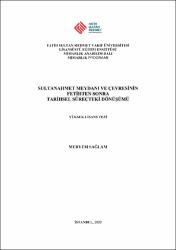Sultanahmet Meydanı ve Çevresinin Fetihten Sonra Tarihsel Süreçteki Dönüşümü
Künye
SAĞLAM, Meryem, Sultanahmet Meydanı ve Çevresinin Fetihten Sonra Tarihsel Süreçteki Dönüşümü, Fatih Sultan Mehmet Vakıf Üniversitesi Lisansüstü Eğitim Enstitüsü Mimarlık Anabilim Dalı, Yayımlanmamış Yüksek Lisans Tezi, İstanbul 2020.Özet
UNESCO Dünya Miras Listesine dahil edilen Sultanahmet Meydanının ve çevresindeki anıt yapıların da yer aldığı Sultanahmet Arkeolojik Park Alanı, kent tarihini gözler önüne sermektedir ve eşsiz envanterler sunmaktadır. Sit alanı kapsamında yer alan bu mirasın korunarak geleceğe aktarılması gerekmektedir. Bu amaçla birçok çalışma yapılmış, koruma planları oluşturulmuş, hatta özel imar kanunları çıkartılmıştır. Yasal düzenlemeler ve gerçekleşen afetler Sultanahmet Meydanı ve çevresinde biçimsel değişikliğe sebep olmuştur. Afetler, tarihi ve siyasi olaylar, meydanın sınırlarını yeniden çizmiş, çevresindeki yapıların işlevsel dönüşümü meydanı, sosyal ve ekonomik açıdan etkilemiştir. Bu çalışmada, olaylara parelel şekillenen ve meydanın sınırlarını belirleyen altı yapı seçilmiş ve bu yapılarla tarihi alanın yaklaşık 570 yıllık bir süreçteki dönüşümü anlatılmaya çalışılmıştır. Bu yapılar, günümüzdeki adıyla, ‘‘Sultanahmet Camii’’, ‘‘Ayasofya’’, ‘‘Büyük Saray Kalıntıları ve Mozaik Müzesi’’, ‘‘Türk İslam Sanatları Müzesi’’, ‘‘İstanbul İl Milli Eğitim Müdürlüğü’’ ve ‘‘Marmara Üniversitesi Rektörlüğü’’ dür.
‘‘Sultanahmet Meydanı ve Çevresinin Fetihten Sonra Tarihsel Süreçteki Dönüşümü’’ isimli bu çalışma beş bölümden oluşmaktadır. Birinci bölümde tezin amacı, yöntemi ve kapsamı açıklanmaya çalışılmıştır. İkinci bölümde tarihi yarımadanın tarihsel süreci anlatılmış ve fetihten sonraki süreç ayrıca ele alınmıştır. Üçüncü bölümde, çalışma alanı olan Sultanahmet Meydanı ve 6 yapı incelenerek fetihten itibaren gerçekleşen imar politikalarının meydana etkisi vurgulanmıştır. Dördüncü bölümde ise örneklem seçilen altı yapının kronolojik tarihi açıklanarak her bir yapının geçirmiş olduğu değişimler incelenmiştir. Çalışmanın son bölümünde ise sonuç kısmı yer almaktadır. Bu bölümde önceki bölümlerde yer alan bulgular yorumlanarak, yapıların ve meydanın analizi yapılmıştır. The Sultanahmet Archaeological Park Area, which includes Sultanahmet Square and its surrounding monuments is included in the UNESCO World Heritage List reveals the history of the city and offers unique inventories. This heritage which is within the scope of protected area should be protected and transferred to the future. Many studies have been carried out for this purpose, conservation plans have been created, and even special zoning laws have been enacted.
Many changes and transformations have been took place in the region due to the legal regulations and the disasters that took place. Disasters, historical and political events have redrawn the boundaries of the Square and the functional transformation of the surrounding structures affected the square, socially and economically. In this study,six structures selected that shaped paralel to the events and determined the boundaries of the Square and with these structures, the transformation of the historical site in a period of approximately 570 years has tried to be explained. These buildings, today have known by names "Blue Mosque", "HagiaSophia", " Great Palace ruins and Mosaic Museum’, "Turkish Islamic Arts Museum’, ‘Istanbul Provincial Directorate of National Education’’ and ‘‘Marmara University Rectorate "
Thiswork, titled ‘‘The Transformation of Sultanahmet Square and its surroundings in the historical process after the Conquest’’, consists of five parts. In the first part, the aim, method and scope of the thesis have tried to be explained. In the second section, in the historical process of the historical peninsula from its foundation has been studied and the process in the post-conquest has also been discussed. İn the third chapter, the Square with in the scope of the study has examined and the effect of the 18th century Reconstruction Policies in the after math has emphasized. In the fourth section, each of the six structures have selected in the sample was mention and the end structures were examined in chronological order. The final part of the study contains the conclusion. In this section, structures and the square have analyzed and evaluated.



















